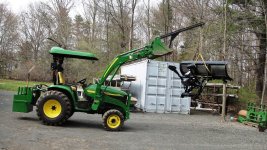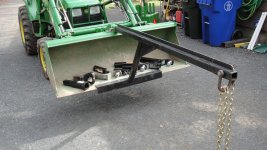Deere Dude
Elite Member
- Joined
- Feb 10, 2011
- Messages
- 3,989
- Tractor
- John Deere 3720
the outboard hooks are fine to the maximum capacity of the loader, they are in a very rigid area, and wrapping them around the bend makes the bucket more rigid and stronger at the lifting point.
the shackle in the middle is there specifically to be the 'fusible link'... i put it there to fail first, before bending the bucket. in as much as the downward and twisting force of the trailer hitch was absorbed by the shackle, an overloading in a lifting capacity would do the same. since this picture was taken, a few good smacks with a 6lbs hammer has repaired the damage to the shackle without causing any damage to the bucket.
the plan obviously works.
if you overload the bucket across a larger section, you simply spread the damage over a greater area... effectively causing more damage. :2cents
After bending the shackle back the strength is greatly reduced and every time after that it will get worse. If that "link" is a must, weld it on a piece of flat stock and just change that if you must so you wouldn't be grinding and welding multiple times on one spot. Why not put a long piece of beefy flat stock welded or bolted on with a regular hook that don't bend? Just wondering. I wouldn't want a heavy load tied down and run the risk of any weak link breaking and having the load fall on someone or getting away on me. I would want it strong enough to where the bucket would fall off before the hook would break. But that's just me. I really like all these various ideas on this link so so I can have multiple choices.

